Strategic Analysis of General Electric: Business Level Strategy Report
VerifiedAdded on 2020/04/21
|16
|5055
|226
Report
AI Summary
This report provides an in-depth analysis of General Electric's (GE) business level strategy, focusing on the strategic shifts implemented by Jeff Immelt after his appointment as CEO in 2001. The report examines the challenges GE faced, including 9/11, corporate scandals, and the 2008 financial crisis, and how Immelt redirected the company's strategy towards consumer focus, innovation, and organic growth. It explores the five crucial elements of Immelt's growth strategy: technical leadership, services acceleration, commercial excellence, globalization, and growth platforms. The analysis includes a discussion of GE's competitive advantages, the application of the BCG matrix, and the alignment of the strategy with the 21st-century business environment, supported by PESTLE analysis. The report also evaluates the extent to which the strategy is aligned with GE's resources and capabilities, emphasizing the company's focus on technological innovation, customer service, and global presence. The report concludes that Immelt's strategy focused on creating a differentiation advantage through innovative products, services, and improved customer focus.
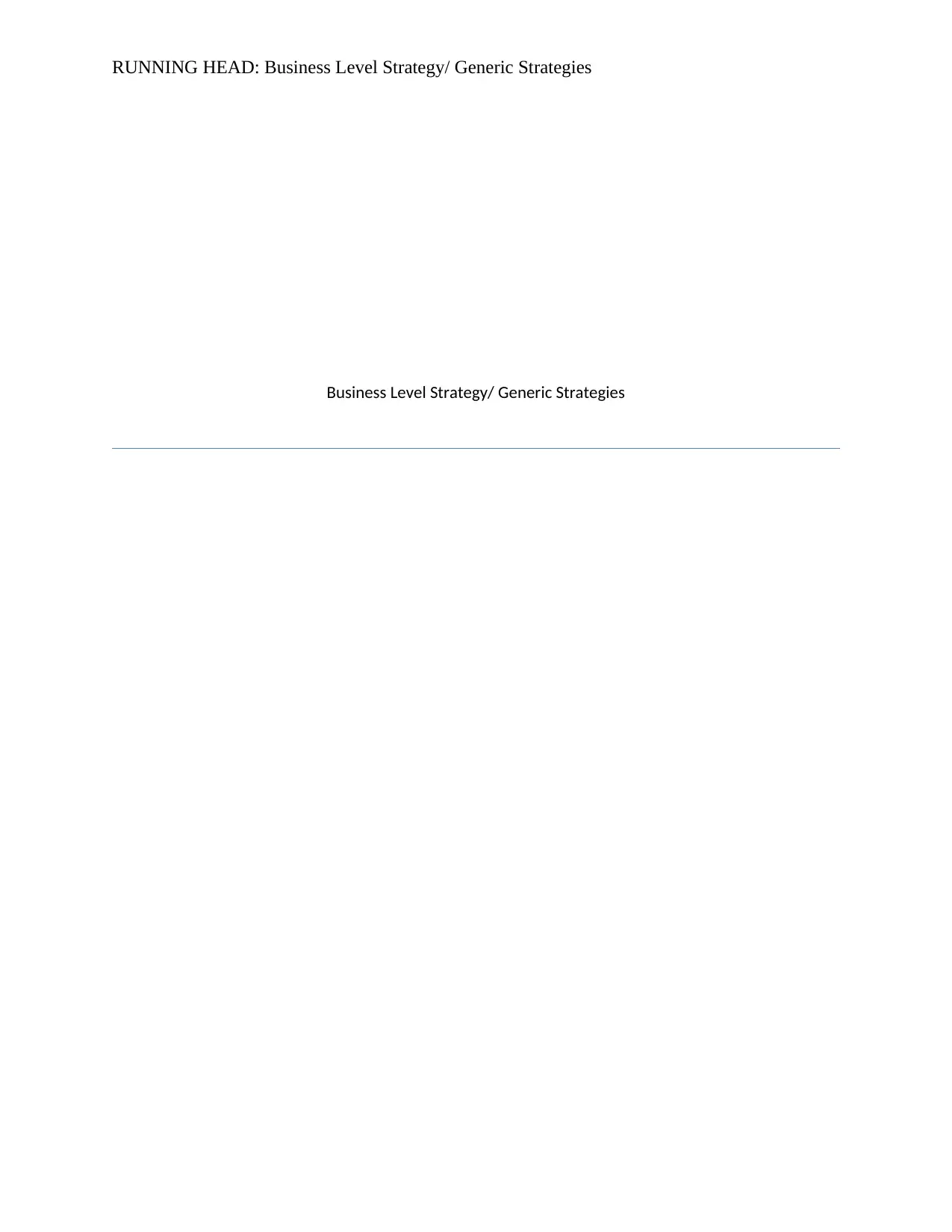
RUNNING HEAD: Business Level Strategy/ Generic Strategies
Business Level Strategy/ Generic Strategies
Business Level Strategy/ Generic Strategies
Paraphrase This Document
Need a fresh take? Get an instant paraphrase of this document with our AI Paraphraser
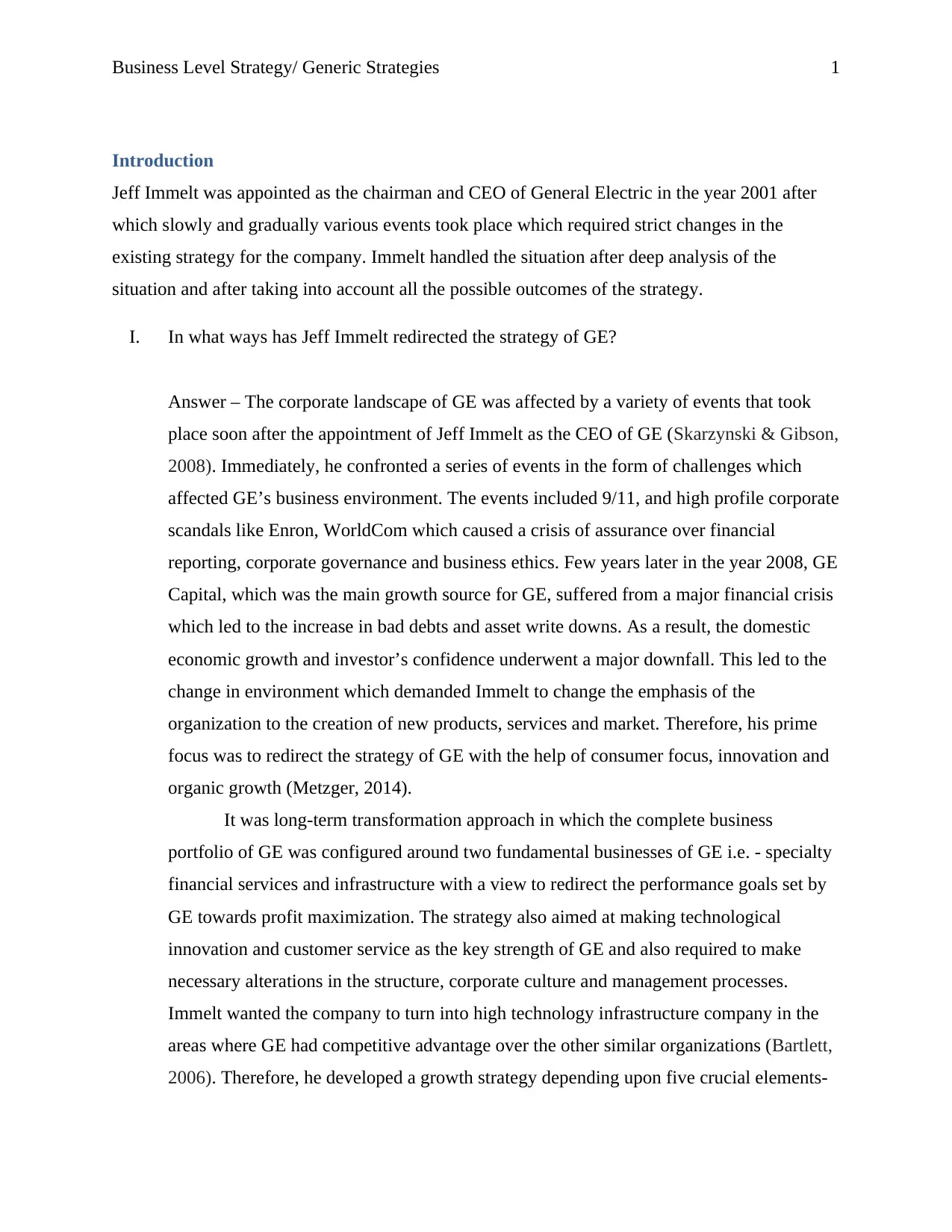
Business Level Strategy/ Generic Strategies 1
Introduction
Jeff Immelt was appointed as the chairman and CEO of General Electric in the year 2001 after
which slowly and gradually various events took place which required strict changes in the
existing strategy for the company. Immelt handled the situation after deep analysis of the
situation and after taking into account all the possible outcomes of the strategy.
I. In what ways has Jeff Immelt redirected the strategy of GE?
Answer – The corporate landscape of GE was affected by a variety of events that took
place soon after the appointment of Jeff Immelt as the CEO of GE (Skarzynski & Gibson,
2008). Immediately, he confronted a series of events in the form of challenges which
affected GE’s business environment. The events included 9/11, and high profile corporate
scandals like Enron, WorldCom which caused a crisis of assurance over financial
reporting, corporate governance and business ethics. Few years later in the year 2008, GE
Capital, which was the main growth source for GE, suffered from a major financial crisis
which led to the increase in bad debts and asset write downs. As a result, the domestic
economic growth and investor’s confidence underwent a major downfall. This led to the
change in environment which demanded Immelt to change the emphasis of the
organization to the creation of new products, services and market. Therefore, his prime
focus was to redirect the strategy of GE with the help of consumer focus, innovation and
organic growth (Metzger, 2014).
It was long-term transformation approach in which the complete business
portfolio of GE was configured around two fundamental businesses of GE i.e. - specialty
financial services and infrastructure with a view to redirect the performance goals set by
GE towards profit maximization. The strategy also aimed at making technological
innovation and customer service as the key strength of GE and also required to make
necessary alterations in the structure, corporate culture and management processes.
Immelt wanted the company to turn into high technology infrastructure company in the
areas where GE had competitive advantage over the other similar organizations (Bartlett,
2006). Therefore, he developed a growth strategy depending upon five crucial elements-
Introduction
Jeff Immelt was appointed as the chairman and CEO of General Electric in the year 2001 after
which slowly and gradually various events took place which required strict changes in the
existing strategy for the company. Immelt handled the situation after deep analysis of the
situation and after taking into account all the possible outcomes of the strategy.
I. In what ways has Jeff Immelt redirected the strategy of GE?
Answer – The corporate landscape of GE was affected by a variety of events that took
place soon after the appointment of Jeff Immelt as the CEO of GE (Skarzynski & Gibson,
2008). Immediately, he confronted a series of events in the form of challenges which
affected GE’s business environment. The events included 9/11, and high profile corporate
scandals like Enron, WorldCom which caused a crisis of assurance over financial
reporting, corporate governance and business ethics. Few years later in the year 2008, GE
Capital, which was the main growth source for GE, suffered from a major financial crisis
which led to the increase in bad debts and asset write downs. As a result, the domestic
economic growth and investor’s confidence underwent a major downfall. This led to the
change in environment which demanded Immelt to change the emphasis of the
organization to the creation of new products, services and market. Therefore, his prime
focus was to redirect the strategy of GE with the help of consumer focus, innovation and
organic growth (Metzger, 2014).
It was long-term transformation approach in which the complete business
portfolio of GE was configured around two fundamental businesses of GE i.e. - specialty
financial services and infrastructure with a view to redirect the performance goals set by
GE towards profit maximization. The strategy also aimed at making technological
innovation and customer service as the key strength of GE and also required to make
necessary alterations in the structure, corporate culture and management processes.
Immelt wanted the company to turn into high technology infrastructure company in the
areas where GE had competitive advantage over the other similar organizations (Bartlett,
2006). Therefore, he developed a growth strategy depending upon five crucial elements-
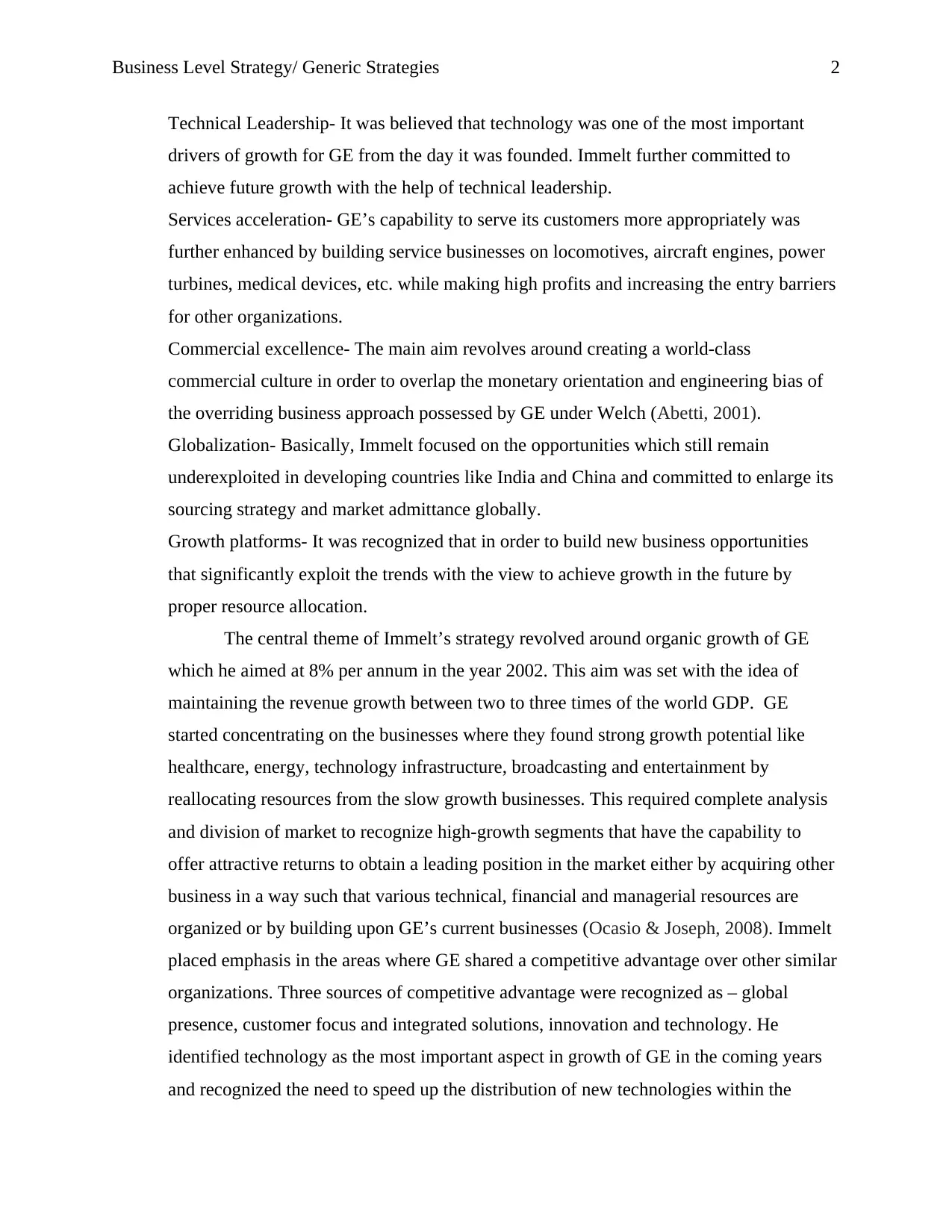
Business Level Strategy/ Generic Strategies 2
Technical Leadership- It was believed that technology was one of the most important
drivers of growth for GE from the day it was founded. Immelt further committed to
achieve future growth with the help of technical leadership.
Services acceleration- GE’s capability to serve its customers more appropriately was
further enhanced by building service businesses on locomotives, aircraft engines, power
turbines, medical devices, etc. while making high profits and increasing the entry barriers
for other organizations.
Commercial excellence- The main aim revolves around creating a world-class
commercial culture in order to overlap the monetary orientation and engineering bias of
the overriding business approach possessed by GE under Welch (Abetti, 2001).
Globalization- Basically, Immelt focused on the opportunities which still remain
underexploited in developing countries like India and China and committed to enlarge its
sourcing strategy and market admittance globally.
Growth platforms- It was recognized that in order to build new business opportunities
that significantly exploit the trends with the view to achieve growth in the future by
proper resource allocation.
The central theme of Immelt’s strategy revolved around organic growth of GE
which he aimed at 8% per annum in the year 2002. This aim was set with the idea of
maintaining the revenue growth between two to three times of the world GDP. GE
started concentrating on the businesses where they found strong growth potential like
healthcare, energy, technology infrastructure, broadcasting and entertainment by
reallocating resources from the slow growth businesses. This required complete analysis
and division of market to recognize high-growth segments that have the capability to
offer attractive returns to obtain a leading position in the market either by acquiring other
business in a way such that various technical, financial and managerial resources are
organized or by building upon GE’s current businesses (Ocasio & Joseph, 2008). Immelt
placed emphasis in the areas where GE shared a competitive advantage over other similar
organizations. Three sources of competitive advantage were recognized as – global
presence, customer focus and integrated solutions, innovation and technology. He
identified technology as the most important aspect in growth of GE in the coming years
and recognized the need to speed up the distribution of new technologies within the
Technical Leadership- It was believed that technology was one of the most important
drivers of growth for GE from the day it was founded. Immelt further committed to
achieve future growth with the help of technical leadership.
Services acceleration- GE’s capability to serve its customers more appropriately was
further enhanced by building service businesses on locomotives, aircraft engines, power
turbines, medical devices, etc. while making high profits and increasing the entry barriers
for other organizations.
Commercial excellence- The main aim revolves around creating a world-class
commercial culture in order to overlap the monetary orientation and engineering bias of
the overriding business approach possessed by GE under Welch (Abetti, 2001).
Globalization- Basically, Immelt focused on the opportunities which still remain
underexploited in developing countries like India and China and committed to enlarge its
sourcing strategy and market admittance globally.
Growth platforms- It was recognized that in order to build new business opportunities
that significantly exploit the trends with the view to achieve growth in the future by
proper resource allocation.
The central theme of Immelt’s strategy revolved around organic growth of GE
which he aimed at 8% per annum in the year 2002. This aim was set with the idea of
maintaining the revenue growth between two to three times of the world GDP. GE
started concentrating on the businesses where they found strong growth potential like
healthcare, energy, technology infrastructure, broadcasting and entertainment by
reallocating resources from the slow growth businesses. This required complete analysis
and division of market to recognize high-growth segments that have the capability to
offer attractive returns to obtain a leading position in the market either by acquiring other
business in a way such that various technical, financial and managerial resources are
organized or by building upon GE’s current businesses (Ocasio & Joseph, 2008). Immelt
placed emphasis in the areas where GE shared a competitive advantage over other similar
organizations. Three sources of competitive advantage were recognized as – global
presence, customer focus and integrated solutions, innovation and technology. He
identified technology as the most important aspect in growth of GE in the coming years
and recognized the need to speed up the distribution of new technologies within the
⊘ This is a preview!⊘
Do you want full access?
Subscribe today to unlock all pages.

Trusted by 1+ million students worldwide
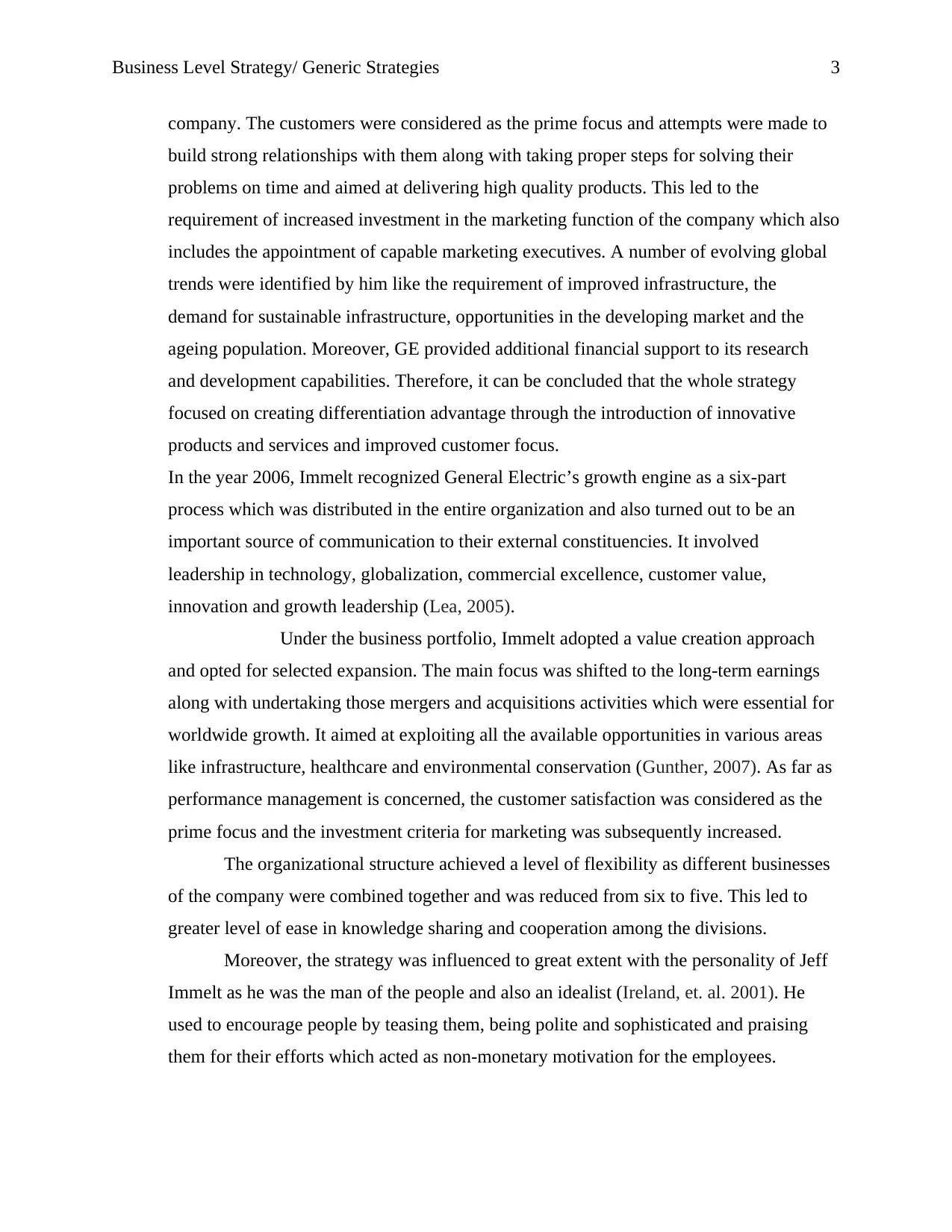
Business Level Strategy/ Generic Strategies 3
company. The customers were considered as the prime focus and attempts were made to
build strong relationships with them along with taking proper steps for solving their
problems on time and aimed at delivering high quality products. This led to the
requirement of increased investment in the marketing function of the company which also
includes the appointment of capable marketing executives. A number of evolving global
trends were identified by him like the requirement of improved infrastructure, the
demand for sustainable infrastructure, opportunities in the developing market and the
ageing population. Moreover, GE provided additional financial support to its research
and development capabilities. Therefore, it can be concluded that the whole strategy
focused on creating differentiation advantage through the introduction of innovative
products and services and improved customer focus.
In the year 2006, Immelt recognized General Electric’s growth engine as a six-part
process which was distributed in the entire organization and also turned out to be an
important source of communication to their external constituencies. It involved
leadership in technology, globalization, commercial excellence, customer value,
innovation and growth leadership (Lea, 2005).
Under the business portfolio, Immelt adopted a value creation approach
and opted for selected expansion. The main focus was shifted to the long-term earnings
along with undertaking those mergers and acquisitions activities which were essential for
worldwide growth. It aimed at exploiting all the available opportunities in various areas
like infrastructure, healthcare and environmental conservation (Gunther, 2007). As far as
performance management is concerned, the customer satisfaction was considered as the
prime focus and the investment criteria for marketing was subsequently increased.
The organizational structure achieved a level of flexibility as different businesses
of the company were combined together and was reduced from six to five. This led to
greater level of ease in knowledge sharing and cooperation among the divisions.
Moreover, the strategy was influenced to great extent with the personality of Jeff
Immelt as he was the man of the people and also an idealist (Ireland, et. al. 2001). He
used to encourage people by teasing them, being polite and sophisticated and praising
them for their efforts which acted as non-monetary motivation for the employees.
company. The customers were considered as the prime focus and attempts were made to
build strong relationships with them along with taking proper steps for solving their
problems on time and aimed at delivering high quality products. This led to the
requirement of increased investment in the marketing function of the company which also
includes the appointment of capable marketing executives. A number of evolving global
trends were identified by him like the requirement of improved infrastructure, the
demand for sustainable infrastructure, opportunities in the developing market and the
ageing population. Moreover, GE provided additional financial support to its research
and development capabilities. Therefore, it can be concluded that the whole strategy
focused on creating differentiation advantage through the introduction of innovative
products and services and improved customer focus.
In the year 2006, Immelt recognized General Electric’s growth engine as a six-part
process which was distributed in the entire organization and also turned out to be an
important source of communication to their external constituencies. It involved
leadership in technology, globalization, commercial excellence, customer value,
innovation and growth leadership (Lea, 2005).
Under the business portfolio, Immelt adopted a value creation approach
and opted for selected expansion. The main focus was shifted to the long-term earnings
along with undertaking those mergers and acquisitions activities which were essential for
worldwide growth. It aimed at exploiting all the available opportunities in various areas
like infrastructure, healthcare and environmental conservation (Gunther, 2007). As far as
performance management is concerned, the customer satisfaction was considered as the
prime focus and the investment criteria for marketing was subsequently increased.
The organizational structure achieved a level of flexibility as different businesses
of the company were combined together and was reduced from six to five. This led to
greater level of ease in knowledge sharing and cooperation among the divisions.
Moreover, the strategy was influenced to great extent with the personality of Jeff
Immelt as he was the man of the people and also an idealist (Ireland, et. al. 2001). He
used to encourage people by teasing them, being polite and sophisticated and praising
them for their efforts which acted as non-monetary motivation for the employees.
Paraphrase This Document
Need a fresh take? Get an instant paraphrase of this document with our AI Paraphraser
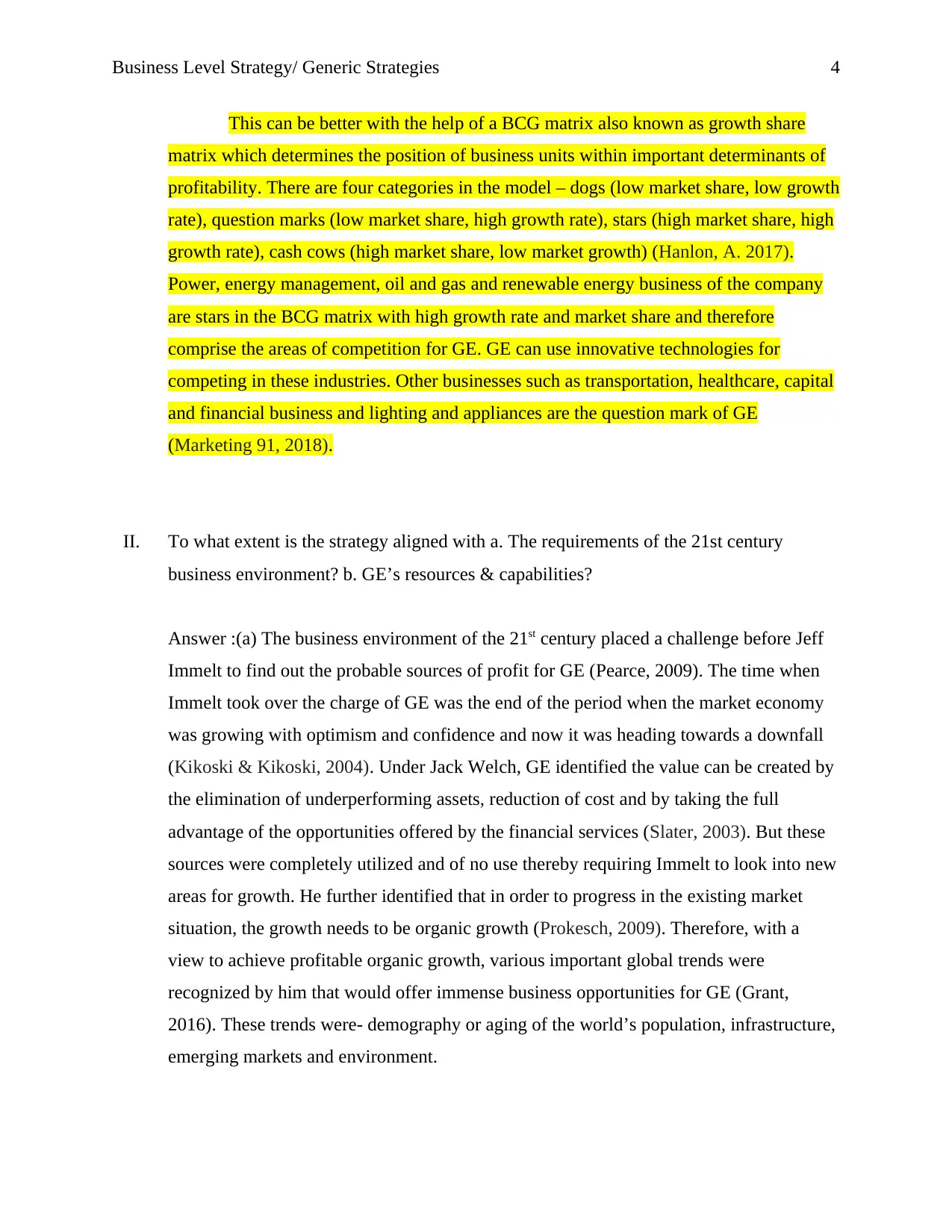
Business Level Strategy/ Generic Strategies 4
This can be better with the help of a BCG matrix also known as growth share
matrix which determines the position of business units within important determinants of
profitability. There are four categories in the model – dogs (low market share, low growth
rate), question marks (low market share, high growth rate), stars (high market share, high
growth rate), cash cows (high market share, low market growth) (Hanlon, A. 2017).
Power, energy management, oil and gas and renewable energy business of the company
are stars in the BCG matrix with high growth rate and market share and therefore
comprise the areas of competition for GE. GE can use innovative technologies for
competing in these industries. Other businesses such as transportation, healthcare, capital
and financial business and lighting and appliances are the question mark of GE
(Marketing 91, 2018).
II. To what extent is the strategy aligned with a. The requirements of the 21st century
business environment? b. GE’s resources & capabilities?
Answer :(a) The business environment of the 21st century placed a challenge before Jeff
Immelt to find out the probable sources of profit for GE (Pearce, 2009). The time when
Immelt took over the charge of GE was the end of the period when the market economy
was growing with optimism and confidence and now it was heading towards a downfall
(Kikoski & Kikoski, 2004). Under Jack Welch, GE identified the value can be created by
the elimination of underperforming assets, reduction of cost and by taking the full
advantage of the opportunities offered by the financial services (Slater, 2003). But these
sources were completely utilized and of no use thereby requiring Immelt to look into new
areas for growth. He further identified that in order to progress in the existing market
situation, the growth needs to be organic growth (Prokesch, 2009). Therefore, with a
view to achieve profitable organic growth, various important global trends were
recognized by him that would offer immense business opportunities for GE (Grant,
2016). These trends were- demography or aging of the world’s population, infrastructure,
emerging markets and environment.
This can be better with the help of a BCG matrix also known as growth share
matrix which determines the position of business units within important determinants of
profitability. There are four categories in the model – dogs (low market share, low growth
rate), question marks (low market share, high growth rate), stars (high market share, high
growth rate), cash cows (high market share, low market growth) (Hanlon, A. 2017).
Power, energy management, oil and gas and renewable energy business of the company
are stars in the BCG matrix with high growth rate and market share and therefore
comprise the areas of competition for GE. GE can use innovative technologies for
competing in these industries. Other businesses such as transportation, healthcare, capital
and financial business and lighting and appliances are the question mark of GE
(Marketing 91, 2018).
II. To what extent is the strategy aligned with a. The requirements of the 21st century
business environment? b. GE’s resources & capabilities?
Answer :(a) The business environment of the 21st century placed a challenge before Jeff
Immelt to find out the probable sources of profit for GE (Pearce, 2009). The time when
Immelt took over the charge of GE was the end of the period when the market economy
was growing with optimism and confidence and now it was heading towards a downfall
(Kikoski & Kikoski, 2004). Under Jack Welch, GE identified the value can be created by
the elimination of underperforming assets, reduction of cost and by taking the full
advantage of the opportunities offered by the financial services (Slater, 2003). But these
sources were completely utilized and of no use thereby requiring Immelt to look into new
areas for growth. He further identified that in order to progress in the existing market
situation, the growth needs to be organic growth (Prokesch, 2009). Therefore, with a
view to achieve profitable organic growth, various important global trends were
recognized by him that would offer immense business opportunities for GE (Grant,
2016). These trends were- demography or aging of the world’s population, infrastructure,
emerging markets and environment.
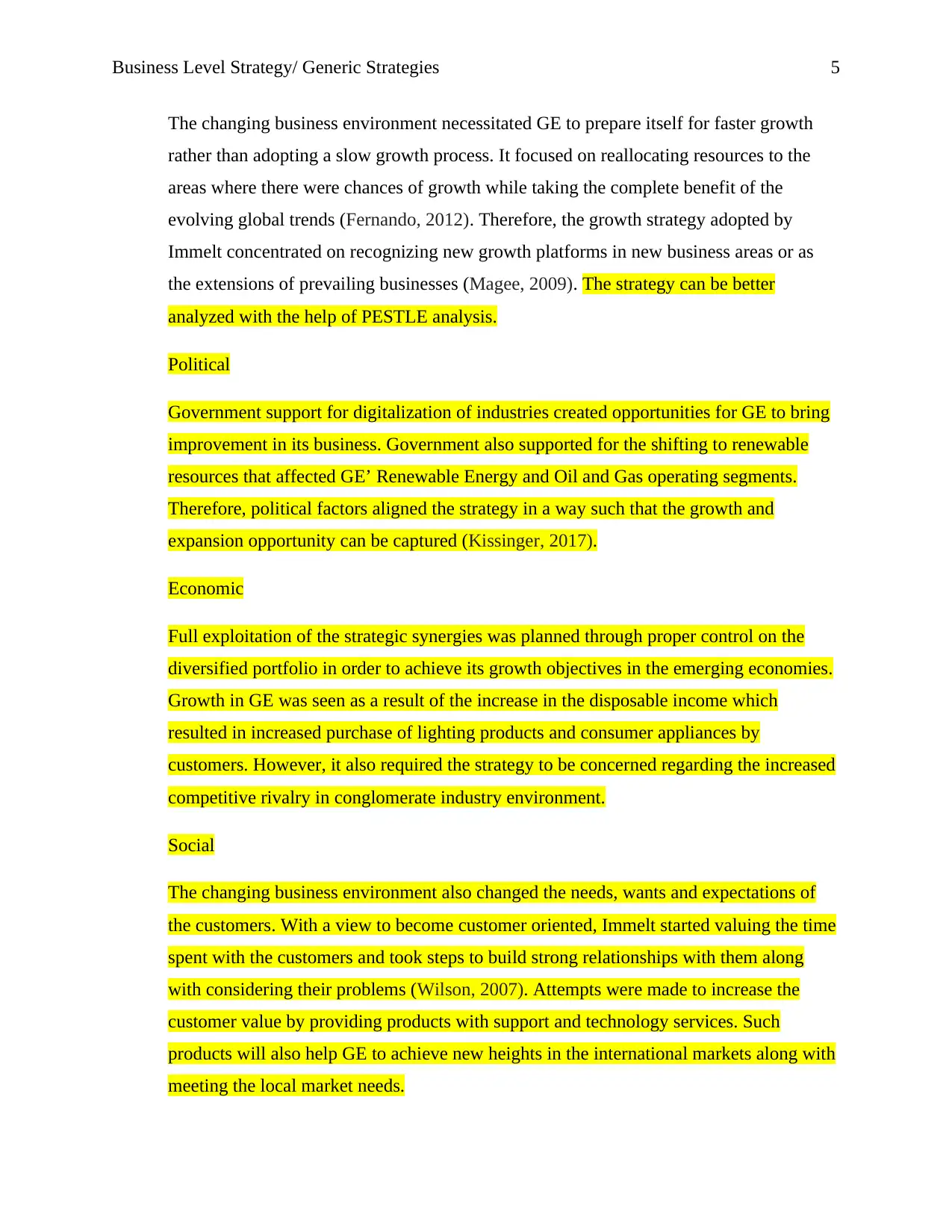
Business Level Strategy/ Generic Strategies 5
The changing business environment necessitated GE to prepare itself for faster growth
rather than adopting a slow growth process. It focused on reallocating resources to the
areas where there were chances of growth while taking the complete benefit of the
evolving global trends (Fernando, 2012). Therefore, the growth strategy adopted by
Immelt concentrated on recognizing new growth platforms in new business areas or as
the extensions of prevailing businesses (Magee, 2009). The strategy can be better
analyzed with the help of PESTLE analysis.
Political
Government support for digitalization of industries created opportunities for GE to bring
improvement in its business. Government also supported for the shifting to renewable
resources that affected GE’ Renewable Energy and Oil and Gas operating segments.
Therefore, political factors aligned the strategy in a way such that the growth and
expansion opportunity can be captured (Kissinger, 2017).
Economic
Full exploitation of the strategic synergies was planned through proper control on the
diversified portfolio in order to achieve its growth objectives in the emerging economies.
Growth in GE was seen as a result of the increase in the disposable income which
resulted in increased purchase of lighting products and consumer appliances by
customers. However, it also required the strategy to be concerned regarding the increased
competitive rivalry in conglomerate industry environment.
Social
The changing business environment also changed the needs, wants and expectations of
the customers. With a view to become customer oriented, Immelt started valuing the time
spent with the customers and took steps to build strong relationships with them along
with considering their problems (Wilson, 2007). Attempts were made to increase the
customer value by providing products with support and technology services. Such
products will also help GE to achieve new heights in the international markets along with
meeting the local market needs.
The changing business environment necessitated GE to prepare itself for faster growth
rather than adopting a slow growth process. It focused on reallocating resources to the
areas where there were chances of growth while taking the complete benefit of the
evolving global trends (Fernando, 2012). Therefore, the growth strategy adopted by
Immelt concentrated on recognizing new growth platforms in new business areas or as
the extensions of prevailing businesses (Magee, 2009). The strategy can be better
analyzed with the help of PESTLE analysis.
Political
Government support for digitalization of industries created opportunities for GE to bring
improvement in its business. Government also supported for the shifting to renewable
resources that affected GE’ Renewable Energy and Oil and Gas operating segments.
Therefore, political factors aligned the strategy in a way such that the growth and
expansion opportunity can be captured (Kissinger, 2017).
Economic
Full exploitation of the strategic synergies was planned through proper control on the
diversified portfolio in order to achieve its growth objectives in the emerging economies.
Growth in GE was seen as a result of the increase in the disposable income which
resulted in increased purchase of lighting products and consumer appliances by
customers. However, it also required the strategy to be concerned regarding the increased
competitive rivalry in conglomerate industry environment.
Social
The changing business environment also changed the needs, wants and expectations of
the customers. With a view to become customer oriented, Immelt started valuing the time
spent with the customers and took steps to build strong relationships with them along
with considering their problems (Wilson, 2007). Attempts were made to increase the
customer value by providing products with support and technology services. Such
products will also help GE to achieve new heights in the international markets along with
meeting the local market needs.
⊘ This is a preview!⊘
Do you want full access?
Subscribe today to unlock all pages.

Trusted by 1+ million students worldwide
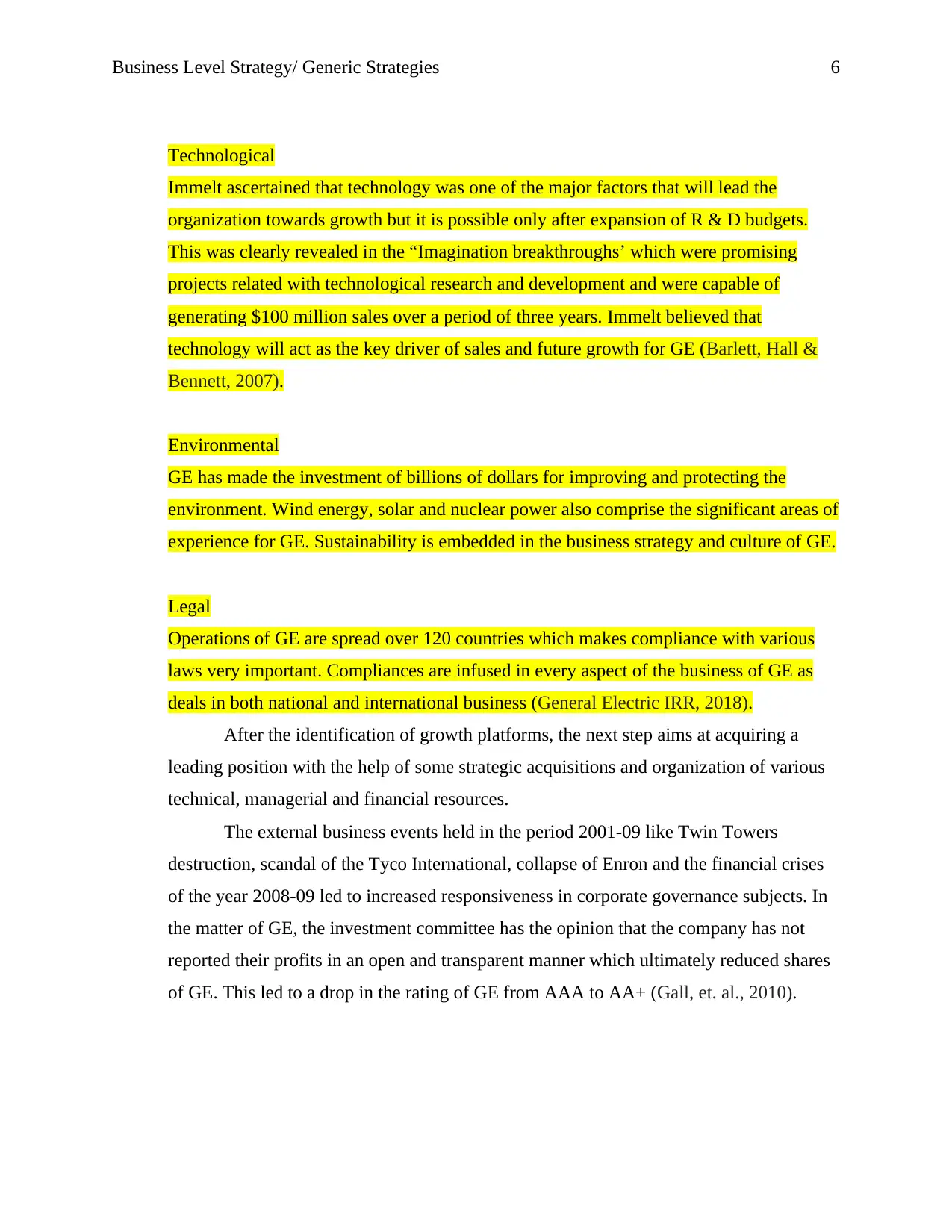
Business Level Strategy/ Generic Strategies 6
Technological
Immelt ascertained that technology was one of the major factors that will lead the
organization towards growth but it is possible only after expansion of R & D budgets.
This was clearly revealed in the “Imagination breakthroughs’ which were promising
projects related with technological research and development and were capable of
generating $100 million sales over a period of three years. Immelt believed that
technology will act as the key driver of sales and future growth for GE (Barlett, Hall &
Bennett, 2007).
Environmental
GE has made the investment of billions of dollars for improving and protecting the
environment. Wind energy, solar and nuclear power also comprise the significant areas of
experience for GE. Sustainability is embedded in the business strategy and culture of GE.
Legal
Operations of GE are spread over 120 countries which makes compliance with various
laws very important. Compliances are infused in every aspect of the business of GE as
deals in both national and international business (General Electric IRR, 2018).
After the identification of growth platforms, the next step aims at acquiring a
leading position with the help of some strategic acquisitions and organization of various
technical, managerial and financial resources.
The external business events held in the period 2001-09 like Twin Towers
destruction, scandal of the Tyco International, collapse of Enron and the financial crises
of the year 2008-09 led to increased responsiveness in corporate governance subjects. In
the matter of GE, the investment committee has the opinion that the company has not
reported their profits in an open and transparent manner which ultimately reduced shares
of GE. This led to a drop in the rating of GE from AAA to AA+ (Gall, et. al., 2010).
Technological
Immelt ascertained that technology was one of the major factors that will lead the
organization towards growth but it is possible only after expansion of R & D budgets.
This was clearly revealed in the “Imagination breakthroughs’ which were promising
projects related with technological research and development and were capable of
generating $100 million sales over a period of three years. Immelt believed that
technology will act as the key driver of sales and future growth for GE (Barlett, Hall &
Bennett, 2007).
Environmental
GE has made the investment of billions of dollars for improving and protecting the
environment. Wind energy, solar and nuclear power also comprise the significant areas of
experience for GE. Sustainability is embedded in the business strategy and culture of GE.
Legal
Operations of GE are spread over 120 countries which makes compliance with various
laws very important. Compliances are infused in every aspect of the business of GE as
deals in both national and international business (General Electric IRR, 2018).
After the identification of growth platforms, the next step aims at acquiring a
leading position with the help of some strategic acquisitions and organization of various
technical, managerial and financial resources.
The external business events held in the period 2001-09 like Twin Towers
destruction, scandal of the Tyco International, collapse of Enron and the financial crises
of the year 2008-09 led to increased responsiveness in corporate governance subjects. In
the matter of GE, the investment committee has the opinion that the company has not
reported their profits in an open and transparent manner which ultimately reduced shares
of GE. This led to a drop in the rating of GE from AAA to AA+ (Gall, et. al., 2010).
Paraphrase This Document
Need a fresh take? Get an instant paraphrase of this document with our AI Paraphraser
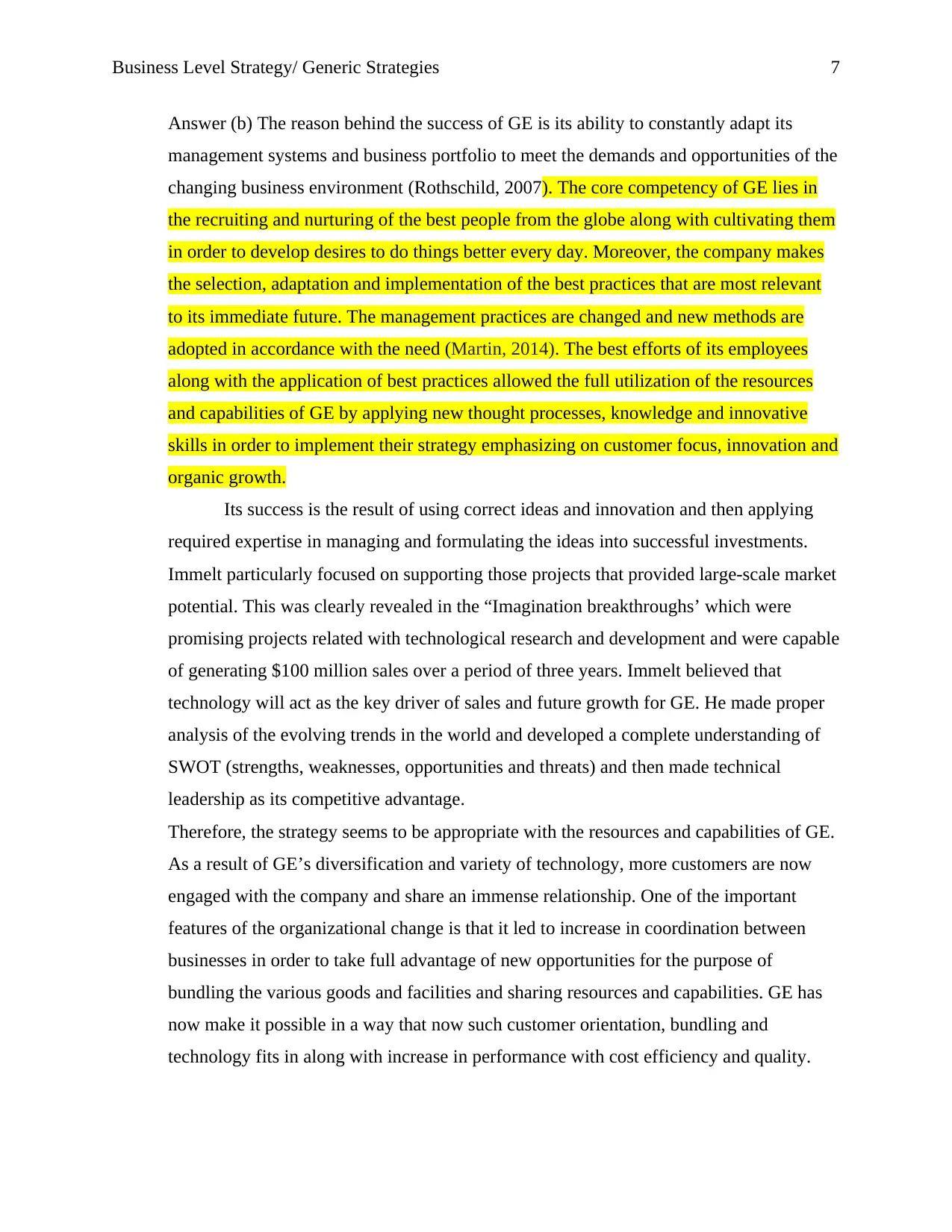
Business Level Strategy/ Generic Strategies 7
Answer (b) The reason behind the success of GE is its ability to constantly adapt its
management systems and business portfolio to meet the demands and opportunities of the
changing business environment (Rothschild, 2007). The core competency of GE lies in
the recruiting and nurturing of the best people from the globe along with cultivating them
in order to develop desires to do things better every day. Moreover, the company makes
the selection, adaptation and implementation of the best practices that are most relevant
to its immediate future. The management practices are changed and new methods are
adopted in accordance with the need (Martin, 2014). The best efforts of its employees
along with the application of best practices allowed the full utilization of the resources
and capabilities of GE by applying new thought processes, knowledge and innovative
skills in order to implement their strategy emphasizing on customer focus, innovation and
organic growth.
Its success is the result of using correct ideas and innovation and then applying
required expertise in managing and formulating the ideas into successful investments.
Immelt particularly focused on supporting those projects that provided large-scale market
potential. This was clearly revealed in the “Imagination breakthroughs’ which were
promising projects related with technological research and development and were capable
of generating $100 million sales over a period of three years. Immelt believed that
technology will act as the key driver of sales and future growth for GE. He made proper
analysis of the evolving trends in the world and developed a complete understanding of
SWOT (strengths, weaknesses, opportunities and threats) and then made technical
leadership as its competitive advantage.
Therefore, the strategy seems to be appropriate with the resources and capabilities of GE.
As a result of GE’s diversification and variety of technology, more customers are now
engaged with the company and share an immense relationship. One of the important
features of the organizational change is that it led to increase in coordination between
businesses in order to take full advantage of new opportunities for the purpose of
bundling the various goods and facilities and sharing resources and capabilities. GE has
now make it possible in a way that now such customer orientation, bundling and
technology fits in along with increase in performance with cost efficiency and quality.
Answer (b) The reason behind the success of GE is its ability to constantly adapt its
management systems and business portfolio to meet the demands and opportunities of the
changing business environment (Rothschild, 2007). The core competency of GE lies in
the recruiting and nurturing of the best people from the globe along with cultivating them
in order to develop desires to do things better every day. Moreover, the company makes
the selection, adaptation and implementation of the best practices that are most relevant
to its immediate future. The management practices are changed and new methods are
adopted in accordance with the need (Martin, 2014). The best efforts of its employees
along with the application of best practices allowed the full utilization of the resources
and capabilities of GE by applying new thought processes, knowledge and innovative
skills in order to implement their strategy emphasizing on customer focus, innovation and
organic growth.
Its success is the result of using correct ideas and innovation and then applying
required expertise in managing and formulating the ideas into successful investments.
Immelt particularly focused on supporting those projects that provided large-scale market
potential. This was clearly revealed in the “Imagination breakthroughs’ which were
promising projects related with technological research and development and were capable
of generating $100 million sales over a period of three years. Immelt believed that
technology will act as the key driver of sales and future growth for GE. He made proper
analysis of the evolving trends in the world and developed a complete understanding of
SWOT (strengths, weaknesses, opportunities and threats) and then made technical
leadership as its competitive advantage.
Therefore, the strategy seems to be appropriate with the resources and capabilities of GE.
As a result of GE’s diversification and variety of technology, more customers are now
engaged with the company and share an immense relationship. One of the important
features of the organizational change is that it led to increase in coordination between
businesses in order to take full advantage of new opportunities for the purpose of
bundling the various goods and facilities and sharing resources and capabilities. GE has
now make it possible in a way that now such customer orientation, bundling and
technology fits in along with increase in performance with cost efficiency and quality.
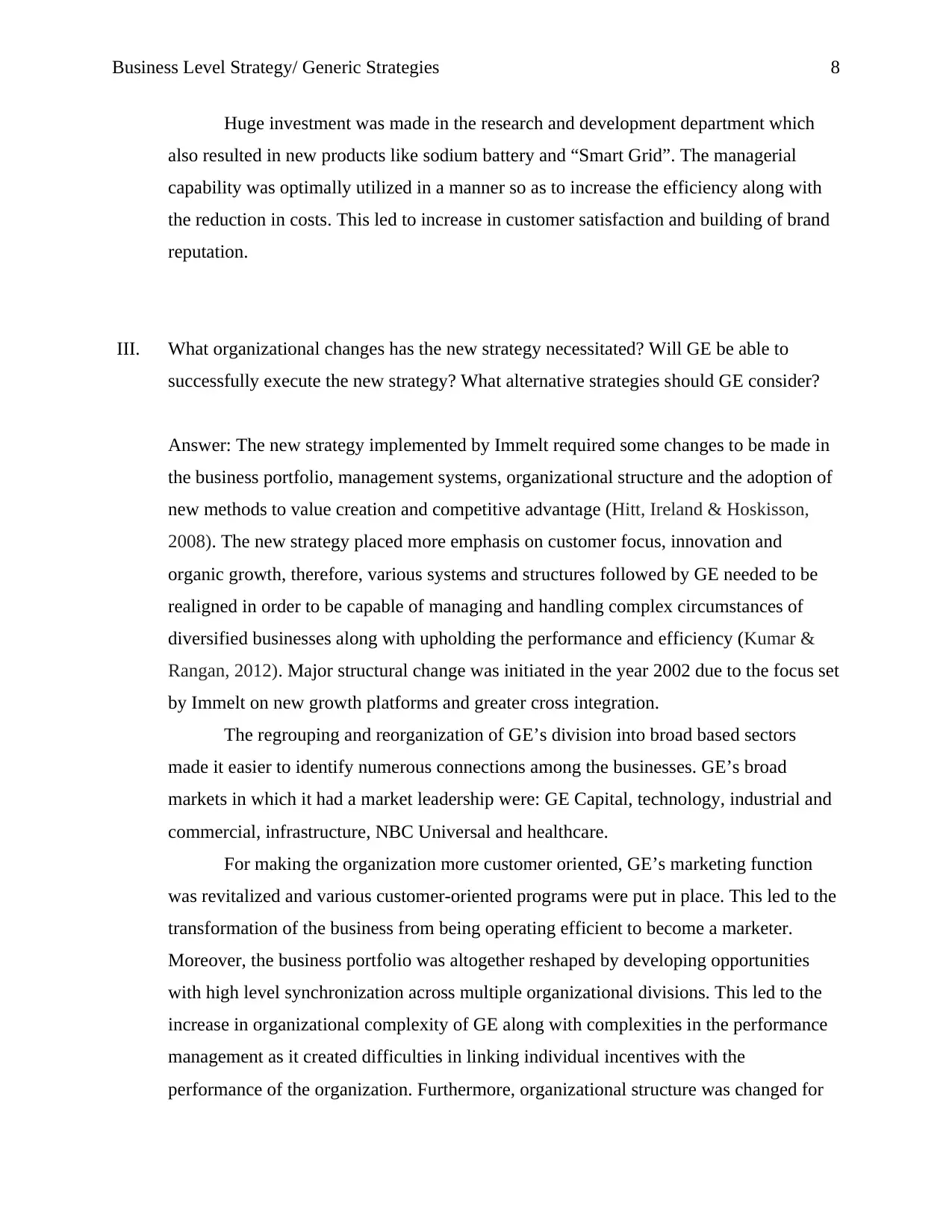
Business Level Strategy/ Generic Strategies 8
Huge investment was made in the research and development department which
also resulted in new products like sodium battery and “Smart Grid”. The managerial
capability was optimally utilized in a manner so as to increase the efficiency along with
the reduction in costs. This led to increase in customer satisfaction and building of brand
reputation.
III. What organizational changes has the new strategy necessitated? Will GE be able to
successfully execute the new strategy? What alternative strategies should GE consider?
Answer: The new strategy implemented by Immelt required some changes to be made in
the business portfolio, management systems, organizational structure and the adoption of
new methods to value creation and competitive advantage (Hitt, Ireland & Hoskisson,
2008). The new strategy placed more emphasis on customer focus, innovation and
organic growth, therefore, various systems and structures followed by GE needed to be
realigned in order to be capable of managing and handling complex circumstances of
diversified businesses along with upholding the performance and efficiency (Kumar &
Rangan, 2012). Major structural change was initiated in the year 2002 due to the focus set
by Immelt on new growth platforms and greater cross integration.
The regrouping and reorganization of GE’s division into broad based sectors
made it easier to identify numerous connections among the businesses. GE’s broad
markets in which it had a market leadership were: GE Capital, technology, industrial and
commercial, infrastructure, NBC Universal and healthcare.
For making the organization more customer oriented, GE’s marketing function
was revitalized and various customer-oriented programs were put in place. This led to the
transformation of the business from being operating efficient to become a marketer.
Moreover, the business portfolio was altogether reshaped by developing opportunities
with high level synchronization across multiple organizational divisions. This led to the
increase in organizational complexity of GE along with complexities in the performance
management as it created difficulties in linking individual incentives with the
performance of the organization. Furthermore, organizational structure was changed for
Huge investment was made in the research and development department which
also resulted in new products like sodium battery and “Smart Grid”. The managerial
capability was optimally utilized in a manner so as to increase the efficiency along with
the reduction in costs. This led to increase in customer satisfaction and building of brand
reputation.
III. What organizational changes has the new strategy necessitated? Will GE be able to
successfully execute the new strategy? What alternative strategies should GE consider?
Answer: The new strategy implemented by Immelt required some changes to be made in
the business portfolio, management systems, organizational structure and the adoption of
new methods to value creation and competitive advantage (Hitt, Ireland & Hoskisson,
2008). The new strategy placed more emphasis on customer focus, innovation and
organic growth, therefore, various systems and structures followed by GE needed to be
realigned in order to be capable of managing and handling complex circumstances of
diversified businesses along with upholding the performance and efficiency (Kumar &
Rangan, 2012). Major structural change was initiated in the year 2002 due to the focus set
by Immelt on new growth platforms and greater cross integration.
The regrouping and reorganization of GE’s division into broad based sectors
made it easier to identify numerous connections among the businesses. GE’s broad
markets in which it had a market leadership were: GE Capital, technology, industrial and
commercial, infrastructure, NBC Universal and healthcare.
For making the organization more customer oriented, GE’s marketing function
was revitalized and various customer-oriented programs were put in place. This led to the
transformation of the business from being operating efficient to become a marketer.
Moreover, the business portfolio was altogether reshaped by developing opportunities
with high level synchronization across multiple organizational divisions. This led to the
increase in organizational complexity of GE along with complexities in the performance
management as it created difficulties in linking individual incentives with the
performance of the organization. Furthermore, organizational structure was changed for
⊘ This is a preview!⊘
Do you want full access?
Subscribe today to unlock all pages.

Trusted by 1+ million students worldwide
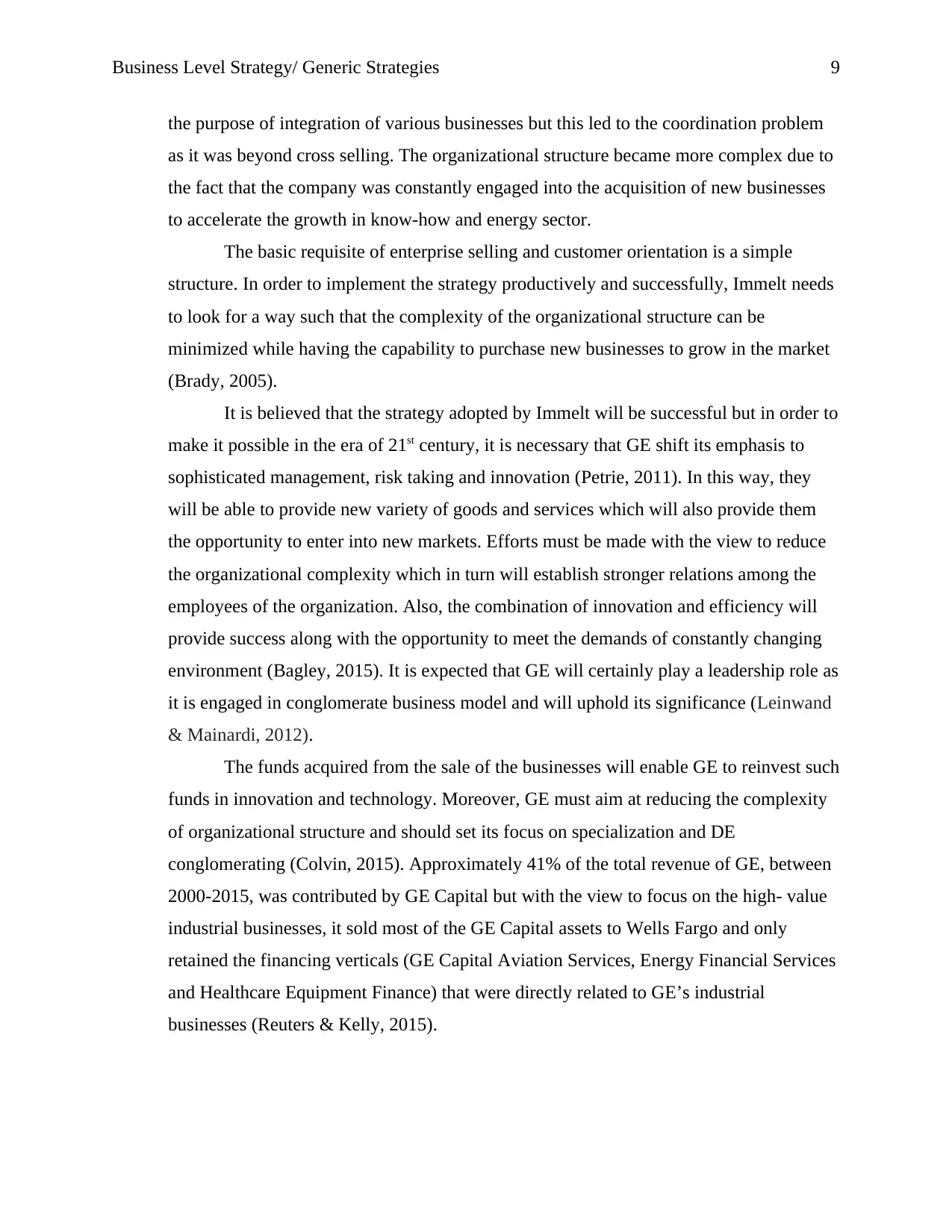
Business Level Strategy/ Generic Strategies 9
the purpose of integration of various businesses but this led to the coordination problem
as it was beyond cross selling. The organizational structure became more complex due to
the fact that the company was constantly engaged into the acquisition of new businesses
to accelerate the growth in know-how and energy sector.
The basic requisite of enterprise selling and customer orientation is a simple
structure. In order to implement the strategy productively and successfully, Immelt needs
to look for a way such that the complexity of the organizational structure can be
minimized while having the capability to purchase new businesses to grow in the market
(Brady, 2005).
It is believed that the strategy adopted by Immelt will be successful but in order to
make it possible in the era of 21st century, it is necessary that GE shift its emphasis to
sophisticated management, risk taking and innovation (Petrie, 2011). In this way, they
will be able to provide new variety of goods and services which will also provide them
the opportunity to enter into new markets. Efforts must be made with the view to reduce
the organizational complexity which in turn will establish stronger relations among the
employees of the organization. Also, the combination of innovation and efficiency will
provide success along with the opportunity to meet the demands of constantly changing
environment (Bagley, 2015). It is expected that GE will certainly play a leadership role as
it is engaged in conglomerate business model and will uphold its significance (Leinwand
& Mainardi, 2012).
The funds acquired from the sale of the businesses will enable GE to reinvest such
funds in innovation and technology. Moreover, GE must aim at reducing the complexity
of organizational structure and should set its focus on specialization and DE
conglomerating (Colvin, 2015). Approximately 41% of the total revenue of GE, between
2000-2015, was contributed by GE Capital but with the view to focus on the high- value
industrial businesses, it sold most of the GE Capital assets to Wells Fargo and only
retained the financing verticals (GE Capital Aviation Services, Energy Financial Services
and Healthcare Equipment Finance) that were directly related to GE’s industrial
businesses (Reuters & Kelly, 2015).
the purpose of integration of various businesses but this led to the coordination problem
as it was beyond cross selling. The organizational structure became more complex due to
the fact that the company was constantly engaged into the acquisition of new businesses
to accelerate the growth in know-how and energy sector.
The basic requisite of enterprise selling and customer orientation is a simple
structure. In order to implement the strategy productively and successfully, Immelt needs
to look for a way such that the complexity of the organizational structure can be
minimized while having the capability to purchase new businesses to grow in the market
(Brady, 2005).
It is believed that the strategy adopted by Immelt will be successful but in order to
make it possible in the era of 21st century, it is necessary that GE shift its emphasis to
sophisticated management, risk taking and innovation (Petrie, 2011). In this way, they
will be able to provide new variety of goods and services which will also provide them
the opportunity to enter into new markets. Efforts must be made with the view to reduce
the organizational complexity which in turn will establish stronger relations among the
employees of the organization. Also, the combination of innovation and efficiency will
provide success along with the opportunity to meet the demands of constantly changing
environment (Bagley, 2015). It is expected that GE will certainly play a leadership role as
it is engaged in conglomerate business model and will uphold its significance (Leinwand
& Mainardi, 2012).
The funds acquired from the sale of the businesses will enable GE to reinvest such
funds in innovation and technology. Moreover, GE must aim at reducing the complexity
of organizational structure and should set its focus on specialization and DE
conglomerating (Colvin, 2015). Approximately 41% of the total revenue of GE, between
2000-2015, was contributed by GE Capital but with the view to focus on the high- value
industrial businesses, it sold most of the GE Capital assets to Wells Fargo and only
retained the financing verticals (GE Capital Aviation Services, Energy Financial Services
and Healthcare Equipment Finance) that were directly related to GE’s industrial
businesses (Reuters & Kelly, 2015).
Paraphrase This Document
Need a fresh take? Get an instant paraphrase of this document with our AI Paraphraser
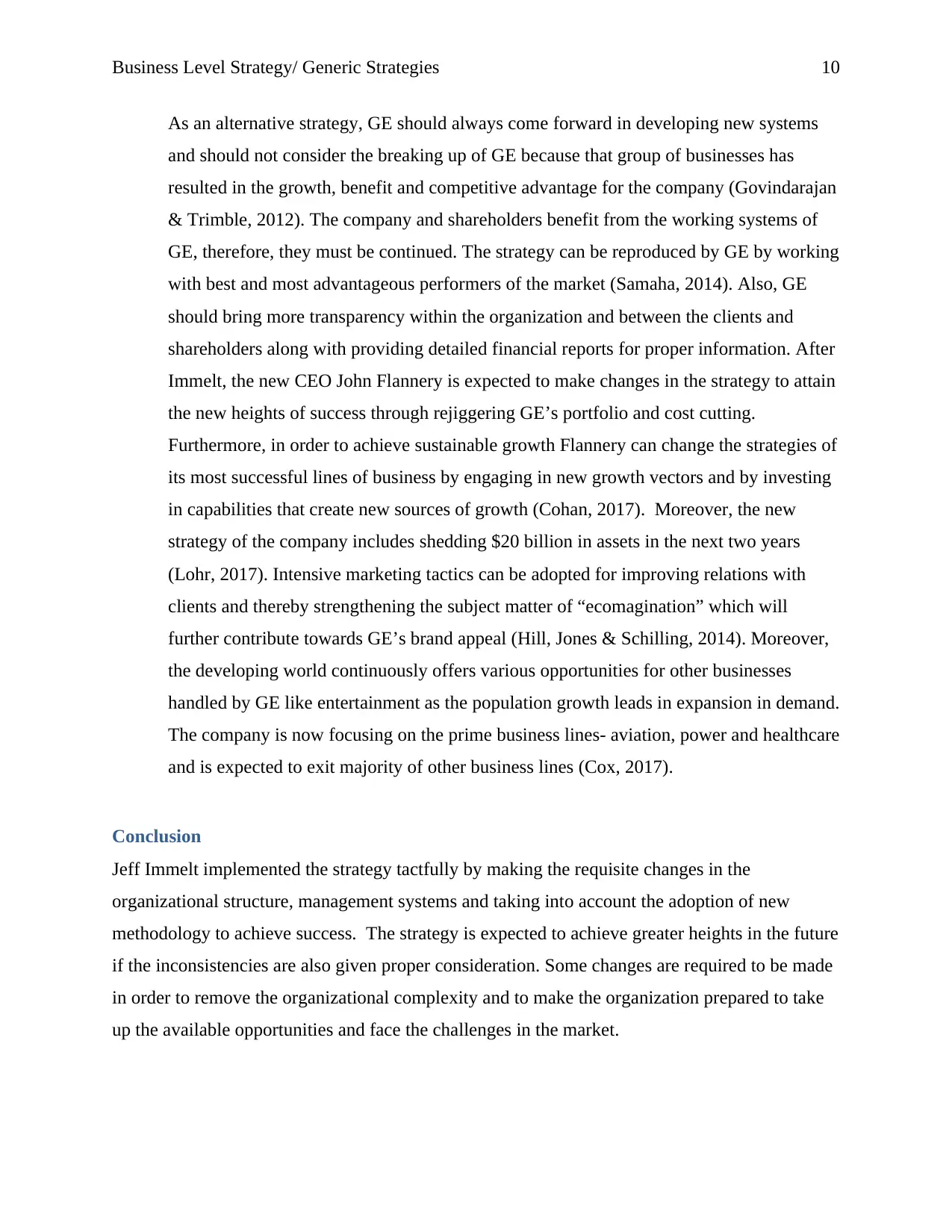
Business Level Strategy/ Generic Strategies 10
As an alternative strategy, GE should always come forward in developing new systems
and should not consider the breaking up of GE because that group of businesses has
resulted in the growth, benefit and competitive advantage for the company (Govindarajan
& Trimble, 2012). The company and shareholders benefit from the working systems of
GE, therefore, they must be continued. The strategy can be reproduced by GE by working
with best and most advantageous performers of the market (Samaha, 2014). Also, GE
should bring more transparency within the organization and between the clients and
shareholders along with providing detailed financial reports for proper information. After
Immelt, the new CEO John Flannery is expected to make changes in the strategy to attain
the new heights of success through rejiggering GE’s portfolio and cost cutting.
Furthermore, in order to achieve sustainable growth Flannery can change the strategies of
its most successful lines of business by engaging in new growth vectors and by investing
in capabilities that create new sources of growth (Cohan, 2017). Moreover, the new
strategy of the company includes shedding $20 billion in assets in the next two years
(Lohr, 2017). Intensive marketing tactics can be adopted for improving relations with
clients and thereby strengthening the subject matter of “ecomagination” which will
further contribute towards GE’s brand appeal (Hill, Jones & Schilling, 2014). Moreover,
the developing world continuously offers various opportunities for other businesses
handled by GE like entertainment as the population growth leads in expansion in demand.
The company is now focusing on the prime business lines- aviation, power and healthcare
and is expected to exit majority of other business lines (Cox, 2017).
Conclusion
Jeff Immelt implemented the strategy tactfully by making the requisite changes in the
organizational structure, management systems and taking into account the adoption of new
methodology to achieve success. The strategy is expected to achieve greater heights in the future
if the inconsistencies are also given proper consideration. Some changes are required to be made
in order to remove the organizational complexity and to make the organization prepared to take
up the available opportunities and face the challenges in the market.
As an alternative strategy, GE should always come forward in developing new systems
and should not consider the breaking up of GE because that group of businesses has
resulted in the growth, benefit and competitive advantage for the company (Govindarajan
& Trimble, 2012). The company and shareholders benefit from the working systems of
GE, therefore, they must be continued. The strategy can be reproduced by GE by working
with best and most advantageous performers of the market (Samaha, 2014). Also, GE
should bring more transparency within the organization and between the clients and
shareholders along with providing detailed financial reports for proper information. After
Immelt, the new CEO John Flannery is expected to make changes in the strategy to attain
the new heights of success through rejiggering GE’s portfolio and cost cutting.
Furthermore, in order to achieve sustainable growth Flannery can change the strategies of
its most successful lines of business by engaging in new growth vectors and by investing
in capabilities that create new sources of growth (Cohan, 2017). Moreover, the new
strategy of the company includes shedding $20 billion in assets in the next two years
(Lohr, 2017). Intensive marketing tactics can be adopted for improving relations with
clients and thereby strengthening the subject matter of “ecomagination” which will
further contribute towards GE’s brand appeal (Hill, Jones & Schilling, 2014). Moreover,
the developing world continuously offers various opportunities for other businesses
handled by GE like entertainment as the population growth leads in expansion in demand.
The company is now focusing on the prime business lines- aviation, power and healthcare
and is expected to exit majority of other business lines (Cox, 2017).
Conclusion
Jeff Immelt implemented the strategy tactfully by making the requisite changes in the
organizational structure, management systems and taking into account the adoption of new
methodology to achieve success. The strategy is expected to achieve greater heights in the future
if the inconsistencies are also given proper consideration. Some changes are required to be made
in order to remove the organizational complexity and to make the organization prepared to take
up the available opportunities and face the challenges in the market.

Business Level Strategy/ Generic Strategies 11
Therefore, it can be concluded that overall the strategy adopted by Immelt has performed very
well in the era of 21st century by focusing on consumer orientation and innovation. Moreover, it
can be said that Immelt has completely recreated GE under his leadership by providing his vision
as a connection of physical and digital world and mixed the elements of flexibility, speed and
scale.
Therefore, it can be concluded that overall the strategy adopted by Immelt has performed very
well in the era of 21st century by focusing on consumer orientation and innovation. Moreover, it
can be said that Immelt has completely recreated GE under his leadership by providing his vision
as a connection of physical and digital world and mixed the elements of flexibility, speed and
scale.
⊘ This is a preview!⊘
Do you want full access?
Subscribe today to unlock all pages.

Trusted by 1+ million students worldwide
1 out of 16
Related Documents
Your All-in-One AI-Powered Toolkit for Academic Success.
+13062052269
info@desklib.com
Available 24*7 on WhatsApp / Email
![[object Object]](/_next/static/media/star-bottom.7253800d.svg)
Unlock your academic potential
Copyright © 2020–2025 A2Z Services. All Rights Reserved. Developed and managed by ZUCOL.





